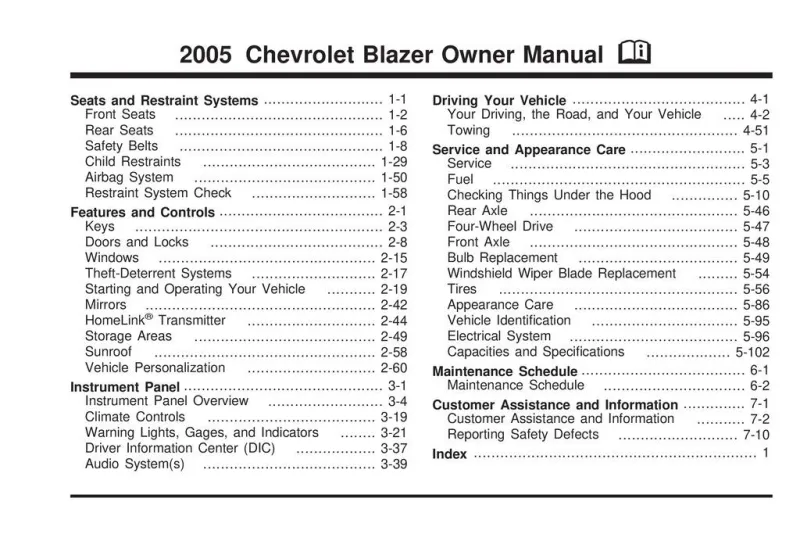2005 Chevrolet Blazer Owner's Manual

Table of Contents
2005 Chevrolet Blazer Overview
Introduction
The 2005 Chevrolet Blazer stands as a testament to rugged utility combined with everyday comfort. Despite being an older model, this midsize SUV captures a sense of adventure while maintaining the practicality that drivers expect from the Chevrolet brand. With its commanding presence, the Blazer is designed for those who seek both on-road reliability and off-road capabilities, making it an appealing choice for families and outdoor enthusiasts alike.
Powertrains
The 2005 Blazer offers a robust selection of powertrains to cater to various driving enthusiast needs. It comes equipped with a standard 4.3-liter V6 engine, delivering an impressive 190 horsepower while providing a capable towing capacity. For those who desire more power and versatility, an optional 5.3-liter V8 engine is available, offering enhanced performance and an exhilarating driving experience. Both engines are paired with a smooth-shifting four-speed automatic transmission, ensuring effortless gear transitions whether navigating city streets or tackling rugged terrains.
Trims
Features
The 2005 Chevrolet Blazer is equipped with a host of features designed for both convenience and safety. Standard equipment includes air conditioning, an AM/FM radio with CD player, and keyless entry. Higher trims offer upgrades such as a premium audio system, power-adjustable seats, and advanced safety options like anti-lock brakes and traction control. These features enhance the overall driving experience, making it not just a vehicle, but a beloved companion on every journey.
Owner's Manual
The 2005 Chevrolet Blazer owner's manual provides indispensable insights for maintaining and optimizing the vehicle. It covers essential topics such as routine maintenance schedules, troubleshooting tips, and operational guidelines for maximizing fuel efficiency. The manual serves as a comprehensive guide for owners, ensuring they can keep their Blazer running smoothly and safely for years to come, enhancing the longevity and reliability of this classic SUV.
User manual download
The Chevrolet Blazer owner manual for the 2005 model year is to be found in PDF downloadable format on this page. The owner manual for the model year 2005 is free and in English, but the repair manuals are usually not easy to get and may cost more.
Manual Questions
Fill the form below and someone will help you!

